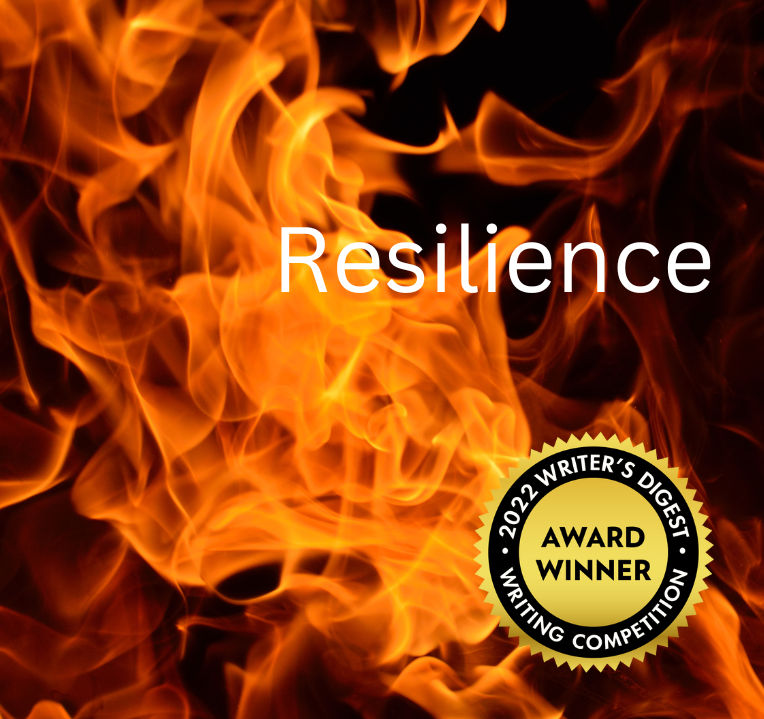
I saw a documentary a few years ago about the giant Sequoia trees and their symbiotic relationship with fire. Fires typically sweep through the trees in 10-to-20-year cycles and the thick redwood bark protects the bottom of the tree from being consumed in flames. The heat of the fire rises to reach the seed cones high up near the canopy. As the cones warm, they spread open and release their seeds. It was mesmerizing to watch this beautiful unfolding through the flames. The seedlings drop to the forest floor and take root in a fertile space that has been cleared of litter and debris by low burning fires. The flames also open holes in the thick forest canopy so that sunlight can reach and nourish the new plants. Fire is one of the factors that contributes to the health and resilience of the giant Sequoias that can live for as many as 3000 years. This resilience, not only in spite of but because of the destructive force of fire, made me think of how grief burns through our lives.
As I contemplate the Redwoods and fire, I view it all painted on the canvas of grief. That is the personal backdrop that has been my existence for over twenty-five years after my husband and two of my children passed, all within five years of each other reducing our family of five to a family of two. My father also passed within that same five years contrasting the grieving process across our most intimate human relationships: parent, spouse, and child.
All of us will grieve at some point in life. The current state of our world is intensifying a rapid-fire succession of collective and personal grieving that underscores the need to manage our lives in a new way. More recently, the wildfires that threaten the sequoias have become unprecedented in their frequency and intensity unnaturally threatening these majestic trees. So, too, we have been stretched to a mounting grief limit with disasters and loss coming into our lives seemingly every day from the pandemic to climate change to political unrest to the next day’s headlines of the most recent disaster.
Resilience takes us beyond merely enduring loss. We emerge from the flames of grief knowing that something precious is gone, but resilience demands that we take something back – that something be restored. What is restored is our true self who we were born to be. We can keep the fire of sorrow at all we have lost burning, continually fighting it back only for it to return until we are completely consumed, or we can let the fire run its course to allow a different life to unfold from the newly discovered seeds within us.
I remember the first time someone challenged me when I made the statement, “I will always live with sorrow.” Usually that statement elicited knowing nods from others who understood profound loss or avoidance and downcast eyes from those who could not imagine it. I have heard over and over again from others that it never gets better. There was something inside of me that innately rejected that notion. I didn’t want to accept that my life was fated to be a life of sorrow and pain. And yet, my life had changed and I hurt. Acceptance meant that I had to acknowledge that the pain will be with me for the rest of my life and that to learn to manage it was the best that I could do.
And I did learn to manage the sorrow after the intensity of the early unmanageable stages of grief burned away. It was exhausting and sometimes my best management skills failed. Without warning, I would burst into tears walking through the grocery store past mint chocolate chip ice cream, my son’s favorite. Hiring a magician for my surviving son’s birthday party and watching his delight brought joy into my life even as I simultaneously held the sorrow that my other children would never celebrate a birthday beyond 9 and 12 years. I learned to hold sorrow and joy together and believed that this was the best I could hope for.
And then I began to wrestle with a new question: If I could choose to not have had my children so that I didn’t have to suffer this lifelong pain of losing them, would I choose that?
The answer was not quite as simple as it first appeared. Immediately, my response was “of course not.” For all the pain of losing my husband and two children in such a short time, I would endure the crippling pain of a broken heart to have had the joy of knowing and loving them. But I realized that that was not an answer that truly explored why this suffering occurred in the first place. Was the price of love really pain?
Our culture demands that response. As parents we would suffer anything for the love of our children. If that meant living a life of sorrow, then that just means we truly loved them. I dug deeper and went below the surface, into the shadows of pain and sorrow, and rejected them as necessary components to prove my love. What would it mean to live my life without the struggle of living with such profound loss? In this scenario, I would have other children. They would not be my same family members but they would be equally wonderful. And what of my surviving son? Logically, he would not exist without my husband. I couldn’t entertain that. This new, wonderful fantasy family would still include my surviving son and I would know great love.
But it would be a narrower dimension of love. The fear and vulnerability of knowing that something bad could happen would live in an imaginary realm that I could avoid visiting because it would never materialize. I would feel blessed and fortunate – grateful every day that my life was as it was meant to be. I have often visualized love on a light spectrum with joy and sorrow at opposite ends with a sweet spot in the middle where you aren’t touched by too much pain, but you are equally limited to reach the immense joy at the other end. Just as our eye can only detect certain wavelengths, our minds only experience emotions in direct proportion to the expansion at either end of this spectrum. In this view, all of life – the sorrow and joy – are merely parts of life. In this new scenario, I would still have sorrows and disappointments but they would be in line with what we are told is the natural order of life. Parents and grandparents would pass after long, healthy lives, but not children.
It was a fantasy that could never satisfy because I could not unknow what my soul had learned. My soul learned that this spectrum was infinite and that love never dies. To feel these truths brought the recognition of a oneness with all of life. Every part of life was a piece of a whole that was bigger and more expansive and my soul had stretched into a far-reaching place that I would have never known without the experiences that have shaped me.
I only know the life I know because of these experiences. Would I go back to being completely undone when the car broke down? Or believing that I needed to prove my worth through vain accomplishments? Or to the myriad of other life challenges that at one time seemed so important and monumental? My soul had grown. My view of life had changed in profound ways. I saw that love encompasses a much fuller spectrum than the one that I could see before. I began to accept life on its terms, not mine.
I am forging deep chasms to learn to live with joy and purpose. The low-burning and brightly-lit fires of grief open up dormant seeds for a new way of living that is multidimensional. Sometimes those fires burn long and hot and I feel like I will be destroyed. Other times the simmering embers lay just below the surface, readying my soul for new growth. This is the life-long journey of grieving.
It was when my friend asked me – “Why – why will you always live with sorrow?” that I truly began to understand resilience. I was able to see that the backdrop of grief that had accompanied me for a quarter-century was as nuanced as the 10 million colors that the human eye can detect. This sorrow was now something I knew and would never not know, this is true. As my life’s spectrum expanded into the depths of sorrow, it proportionally expanded into the far reaches of joy that I could touch after the burning subsided.
My attachment to what I thought life should be fueled the hottest fires and I didn’t want to give up the feeling of somehow being cheated out of a life that was promised but not fulfilled. I wanted life to be an idyllic experience where things made sense. A place where I could control the outcomes in my life by following the rules and being a good person. That way, I would reap the rewards meant for me. A place where happily-ever-after does not fade into enduring-ever-after. Our culture tells me that I am one of the unlucky ones and that reinforces my own struggle with feeling that my life is wrong. That it is not as it should be. I should be one of the lucky ones. And yet, what my mind cannot grasp but my soul fully embraces is that we are all lucky and unlucky in our own ways. There are no “shoulds.” There is only life and eventually death for all of us. I don’t know why my family members died when others have lived through life-threatening illnesses. My asking “why” presupposed that it could have been other than it is. And possibly it could have been, but that is not what happened and I now understand that “why” has become irrelevant. My preconceived and learned ideas of life have been burned away.
I am left with a deep sense of gratitude that I can hold the sorrow of this world, be transformed by it, be stretched to fully embrace the wonder and joy, and discover a visceral love that never dies. Our true resilient selves inhabit these forms, these bodies that are merely temporary addresses. Our children, our spouses, our parents, our most intimate relationships, help us become who we are during our short time on earth to advance our souls to deeper and greater understandings – regardless of how much time we spend with them.
Sorrow is not a permanent state of being. It comes in moments in time that require acknowledgement but not necessarily indulgence. Indulgence is a choice, acknowledgement is not. Grief is a fact. Sometimes we need to choose to indulge our sorrow and let the fires burn hot and fierce. It may be the only way to release the seeds of growth. Other times, we can acknowledge it and let it pass through us, familiar and beautiful in its own way providing the fuel we need to continue living on this expanded spectrum we call life.
Just as the giant Sequoia trees have a symbiotic relationship with fire, so too do we have a symbiotic relationship with sorrow. It is a part of our lives whether we want it to be or not and may be a path to discovering who we truly are and why we are here. Instead of wishing for someone else’s life, or the fantasy of what life should be, I choose my life. Low-burning, as well as fierce and brightly-lit fires have burned and revealed a wondrous on-going mystery exposing the power of a resilient spirit that is part of an unending story of love.

